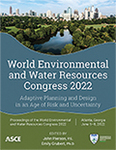Improving Water Resiliency at Military Installations: Addressing Deficiencies through Demand Estimation Planning Tools, Courses of Action Review, and Climate Change Risk Assessment Factors
Publication: World Environmental and Water Resources Congress 2022
ABSTRACT
Army installations, comprised of infrastructure, operations, and services, face countless risks to facilities’ supporting military missions. Resiliency to disruptions is necessary to perform these missions. Disruptions include degradation/obsolescence, natural disasters, or adversary attacks. To mitigate risk and ensure energy and water (E&W) security and resiliency, army installations must develop installation energy and water plans (IEWPs). IEWPs provide a road map for improving security and resiliency of installations. An essential IEWP component is the development of courses of action (COAs) to address deficiencies, improving an installation’s future condition, E&W security, and resilience during normal operations and emergency situations. The objective of this paper is to document water resiliency improvements in military installations by applying critical facilities demand estimation planning tools, completing courses of action reviews, and factoring in climate change. In doing so, the IEWP process improves US Army military readiness through state-of-the-art solutions for improved security, resilience, readiness, and mission assurance.
Get full access to this article
View all available purchase options and get full access to this chapter.
REFERENCES
Anguiano, G., E. Chiang, M. Araujo, V. F. Medina, S. Waisner, W. Condit, J. Matthews, and R. Stowe. (2017). “Innovative Acoustic Sensor Technologies for Leak Detection in Challenging Pipe Types.”. Port Hueneme, CA.
Army Directive 2020-03. (2020). U.S. Army Installation Energy and Water Resilience Policy https://armypubs.army.mil/epubs/DR_pubs/DR_a/pdf/web/ARN21689_AD2020_03_FINAL_Revised.pdf.
Army Directive 2020-08. (2020). U.S. Army Installation Policy to Address Threats Caused by Changing Climate and Extreme Weather. National Defense Authorization Act (NDAA) 2018, Section 335: DoD must report to Congress current climate vulnerabilities and 20-year projections. Implements DoDD 4715.21. Army.mil Article on Army Directive 2020-08 https://www.army.mil/article/238014/new_directive_to_prepare_army_installations_against_extreme_weather_climate_change.
Army Installation Energy and Water Resilience Assessment Guide. (2020).
Barth, E., J. McKernan, D. Bless, and K. Dasu. (2021). “Investigation of an immobilization process for PFAS contaminated soils.” Journal of environmental management. Elsevier Science Ltd, New York, NY, 296:113069. https://doi.org/10.1016/j.jenvman.2021.113069.
Department of Defense Instruction Number 4170.11. (Dec. 11, 2009). Installation Energy Management. https://www.acq.osd.mil/dodsc/library/dodi-4170-11-installation.pdf.
Executive Order 13834. (May 17, 2018). “Efficient Federal Operation.”. p. 23771-23774. https://www.federalregister.gov/documents/2018/05/22/2018-11101/efficient-federal-operations.
Burkhard, L. Evaluation of published bioaccumulation data for per- and polyfluoroalkyl substances across aquatic species. International Conference on Remediation and Management of Contaminated Sediments, Nashville, TN, February 26, 2021. https://doi.org/10.23645/epacomptox.14125988.
Heaps, C. (2015). “Lessons Learned in Net Zero Energy”. Army Net Zero. National Renewable Energy Laboratory (NREL) US DOE. https://www.nrel.gov/docs/fy15osti/62946.pdf.
Medina, V. F., J. L. Johnson, S. A. Waisner, R. Wade, and J. Mattei-Sosa. (2015). “Development of a Treatment Process for Electrodialysis Reversal Reject with Intermediate Softening and Secondary Reverse Osmosis.” Journal of Environmental Engineering. Published Online. https://doi.org/10.1061/(ASCE)EE.1943-7870.0000929.
Medina, V. F., S. A. Waisner, E. Martinez-Guerra, and J. A. Johnson. (2018). “Developing and Testing the Decontamination Effluent Treatment System.” Army Chemical Review. PB 3-18-1.
Medina, V. F., C. S. Griggs, and C. Thomas. (2016). “Evaluation of the Destruction of the Harmful Cyanobacteria, Microcystis aeruginosa, with a cavitation and superoxide generating water treatment reactor.” Bulletin of Environmental Toxicology and Contamination. 96(6):791–796. DOI: https://doi.org/10:1007/S00128-016-1742-6.
Medina, V. F., J. Mattei-Sosa, and C. S. Griggs. (2019). “Method of Recycling Chitosan and Graphene Oxide Compound.”.
National Defense Authorization Act for Fiscal Year 2018. (2017-2018) H.R.2810 - 115th Congress. Public Law No: 115-91. https://www.congress.gov/bill/115th-congress/house-bill/2810/text.
Patterson, C., J. Burkhardt, D. Schupp, E. Krishnan, S. Dyment, S. Merritt, L. Zintek, and D. Kleinmaier. (2021). “Effectiveness of Point-of-Use/Point-of-Entry Systems to Remove Per-and-Poly-fluoroalkyl Substances from Drinking Water.” Edition 1st, Chapter 10, Forever Chemicals: Environmental, Economic, and Social Equity Concerns with PFAS in the Environment. Taylor & Francis Group, London, Uk, 211–235. https://doi.org/10.1201/9781003024521.
Pinson, A. O., K. D. White, S. A. Moore, S. D. Samuelson, B. A. Thames, P. S. O’Brien, C. A. Hiemstra, P. M. Loechl, and E. E. Ritchie. (2020). Army Climate Resilience Handbook. Washington, DC: US Army Corps of Engineers. p.235 https://www.asaie.army.mil/Public/ES/doc/Army_Climate_Resilience_Handbook_Change_1.pdf.
Potochney, P. (2016). Office of the Secretary of Defense (OSD) Installation Energy Plan (IEP) Memorandum for the Office of the Assistant Secretary of Defense. Energy Installations, and Environment. Deputy Assistant Secretary of Defense (Basing). Installation Energy Plans. March 31, 2016.
Surash, J. E., and Dornbos, S. (2020). ARMY Magazine. “Army Climate Assessment Tool (ACAT): Climate Change Hits Home: Assessment Tool Helps Gauge The Way Forward.” https://www.ausa.org/articles/climate-change-hits-homeassessment-tool-helps-gauge-way-forward Dornbos, S. ISWG Brief (2020) https://sftool.gov/Content/attachments/Iswg/iswg-policies-strategies/ISWG_Army_Climate_Resilience_Brief.pdf.
USEPA. (2021). PFAS Explained. https://www.epa.gov/pfas/pfas-explained.
Information & Authors
Information
Published In
History
Published online: Jun 2, 2022
Authors
Metrics & Citations
Metrics
Citations
Download citation
If you have the appropriate software installed, you can download article citation data to the citation manager of your choice. Simply select your manager software from the list below and click Download.
